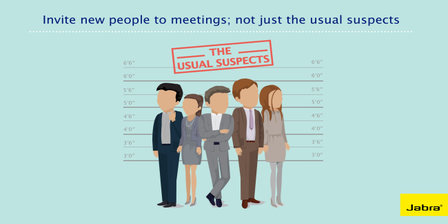Jabra Blog: The Secret to Productive Collaboration By Holger Reisinger
Forget the business books and management gurus. The answer may instead lie in the business practices of a 19th century industrialist: hire smart people with a variety of perspectives, turn them loose and get out of the way.

What I’ve found interesting is the unique way Carnegie ran his vast corporate enterprise. As he explained: “We have a ‘master mind’ here in our business, and that mind is made up of more than a score of people who constitute my personal staff of superintendents and managers and accountants and chemists and other necessary types. No two minds in the group are exactly alike, but each person in the group does the thing that he is supposed to do and he does it better than any other person in the world could do it.”
OK, so maybe he was a little long-winded. But Carnegie was a master of bringing together smart people with a wide variety of perspectives—and setting them loose on a problem.
That got me wondering if that’s how we solve problems today—and I’m not sure that it is.
The “Master Minds” Vs. the “Usual Suspects”
In my experience, we often tackle a business problem by involving people that we know and are comfortable with. Instead of seeking out varying opinions and personalities, we bring in the “usual suspects,” as one of my colleagues calls them. Sure, they may have some expertise in the matter at hand. But do they represent the best team possible?
Unsure if I was on to something, I explained my theory to a friend who earns a living studying corporate behavior. She confirmed my suspicions and explained the science behind how problem-solving teams are built.
She said that in most cases we involve people based on the strength of our social ties to them. If we know someone well or have had a previous relationship, we have what sociologists call strong social ties—and are thus more likely to collaborate with them. If we don’t know them well, we have weak social ties and are less likely to include them.
Of course, there’s nothing wrong with inviting familiar colleagues to join in on the problem solving. But by focusing only on strong social ties, we miss out on the differing perspectives and critical expertise those with weak ties can offer. These insights could be the difference between a successful business idea and a failed one.
Creating a Better Collaborative Culture
So how do you foster productive collaboration with “master minds” and not just the “usual suspects”? Here are a few suggestions:
Identify the problem. Take a hard look at the problem you need to address and determine the specific knowledge you will require to resolve it.
Cast a wide net. Based on your assessment, begin reaching out in your network to address the issue you’ve identified. Ignore job titles and instead focus on recruiting workers with the skills and competencies to solve problems. Strive for as wide an array of backgrounds, opinions, job responsibilities and tenure at the organization as possible.
Get recommendations. Of course, the previous suggestion raises an obvious issue: How to identify those weak ties who may nevertheless be critical to your team? The answer, my friend says, is to request recommendations from colleagues. Don’t be afraid to ask, for example, “Can you recommend a marketing person who has finance experience?”
The next time you’re put in charge of resolving a business problem, take a page from one of the wealthiest men in history. It probably won’t make you a billionaire, but it could make you a hero around the office.
For additional information see Jabra’s Company Profile




